air condition GENESIS G80 2021 Owner's Manual
[x] Cancel search | Manufacturer: GENESIS, Model Year: 2021, Model line: G80, Model: GENESIS G80 2021Pages: 604, PDF Size: 11.47 MB
Page 12 of 604

Introduction1-8
VEHICLE DATA COLLECTION AND EVENT DATA RECORDERS
This vehicle is equipped with an event data recorder (EDR). The main purpose of
an EDR is to record, in certain crash or near crash-like situations, such as an air bag
deployment or hitting a road obstacle, data that will assist in understanding how a
vehicle’s systems performed. The EDR is designed to record data related to vehicle
dynamics and safety systems for a short period of time, typically 30 seconds or less.
The EDR in this vehicle is designed to record such data as:
• How various systems in your vehicle were operating;
• Whether or not the driver and passenger safety belts were buckled/fastened;
• How far (if at all) the driver was depressing the accelerator and/or brake pedal; and,
• How fast the vehicle was traveling.
These data can help provide a better understanding of the circumstances in which
crashes and injuries occur. NOTE: EDR data are recorded by your vehicle only if a
non-trivial crash situation occurs; no data are recorded by the EDR under normal
driving conditions and no personal data (e.g., name, gender, age, and crash location)
are recorded. However, other parties, such as law enforcement, could combine the
EDR data with the type of personally identifying data routinely acquired during a crash
investigation.
To read data recorded by an EDR, special equipment is required, and access to the
vehicle or the EDR is needed. In addition to the vehicle manufacturer, other parties,
such as law enforcement, that have the special equipment, can read the information if
they have access to the vehicle or the EDR.
Page 13 of 604
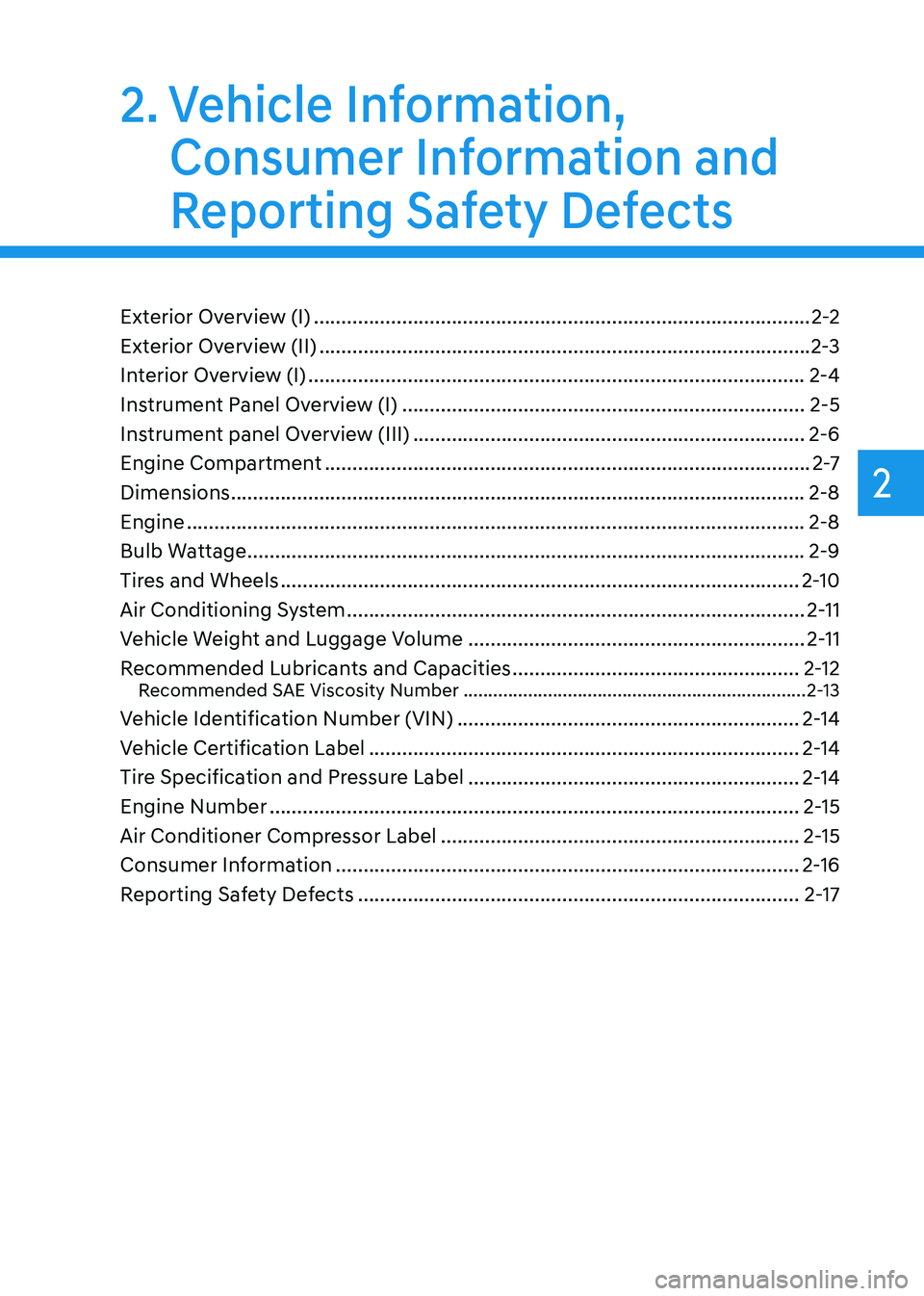
2
2. Vehicle Information,
Consumer Information and
Reporting Safety Defects
Exterior Overview (I) ........................................................................\
..................2-2
Exterior Overview (II)
........................................................................\
.................2-3
Interior Overview (I)
........................................................................\
..................2-4
Instrument Panel Overview (I)
........................................................................\
.2-5
Instrument panel Overview (III)
.......................................................................2-6
Engine Compartment
........................................................................\
................2-7
Dimensions
........................................................................\
................................2-8
Engine
........................................................................\
........................................2-8
Bulb Wattage
........................................................................\
.............................2-9
Tires and Wheels
........................................................................\
......................2-10
Air Conditioning System
........................................................................\
...........2-11
Vehicle Weight and Luggage Volume
.............................................................2-11
Recommended Lubricants and Capacities
....................................................2-12Recommended SAE Viscosity Number .....................................................................2-13
Vehicle Identification Number (VIN) ..............................................................2-14
Vehicle Certification Label
........................................................................\
......2-14
Tire Specification and Pressure Label
............................................................2-14
Engine Number
........................................................................\
........................2-15
Air Conditioner Compressor Label
.................................................................2-15
Consumer Information
........................................................................\
............2-16
Reporting Safety Defects
........................................................................\
........2-17
Vehicle Information, Consumer Information and Reporting Safety Defects
Page 23 of 604

02
2-11
ItemWeight of volume Classification
Refrigerant oz. (g) 22.22±0.88 (630±25)
R-1234yf
Compressor
lubricant cu. in (cc) 3.52±0.35 (100±10)
PAG (FD46XG)
Contact an authorized retailer of Genesis Branded products dealer for more details.
VEHICLE WEIGHT AND LUGGAGE VOLUME
Item 2.5L T-GDI
3.5L T-GDI
2WD AWD 2WDAWD
Gross vehicle
weight 5104 lbs.
(2315 kg) 5258 lbs.
(2385 kg) 5412 lbs.
(2455 kg) 5567 lbs.
(2525 kg)
Luggage volume
Items 2.5L T-GDI 3.5L T-GDI
SAE 13.1 cu ft (371 ℓ)
AIR CONDITIONING SYSTEM
Page 27 of 604

02
2-15
ENGINE NUMBER
„„2.5L T-GDI
ORG3010021
„„3.5L T-GDI
ORG3010024
The engine number is stamped on the
engine block as shown in the drawing.
AIR CONDITIONER
COMPRESSOR LABEL
OHI088008L
A compressor label informs you the type
of compressor your vehicle is equipped
with such as model, supplier part
number, production number, refrigerant
(1) and refrigerant oil (2).
Page 31 of 604
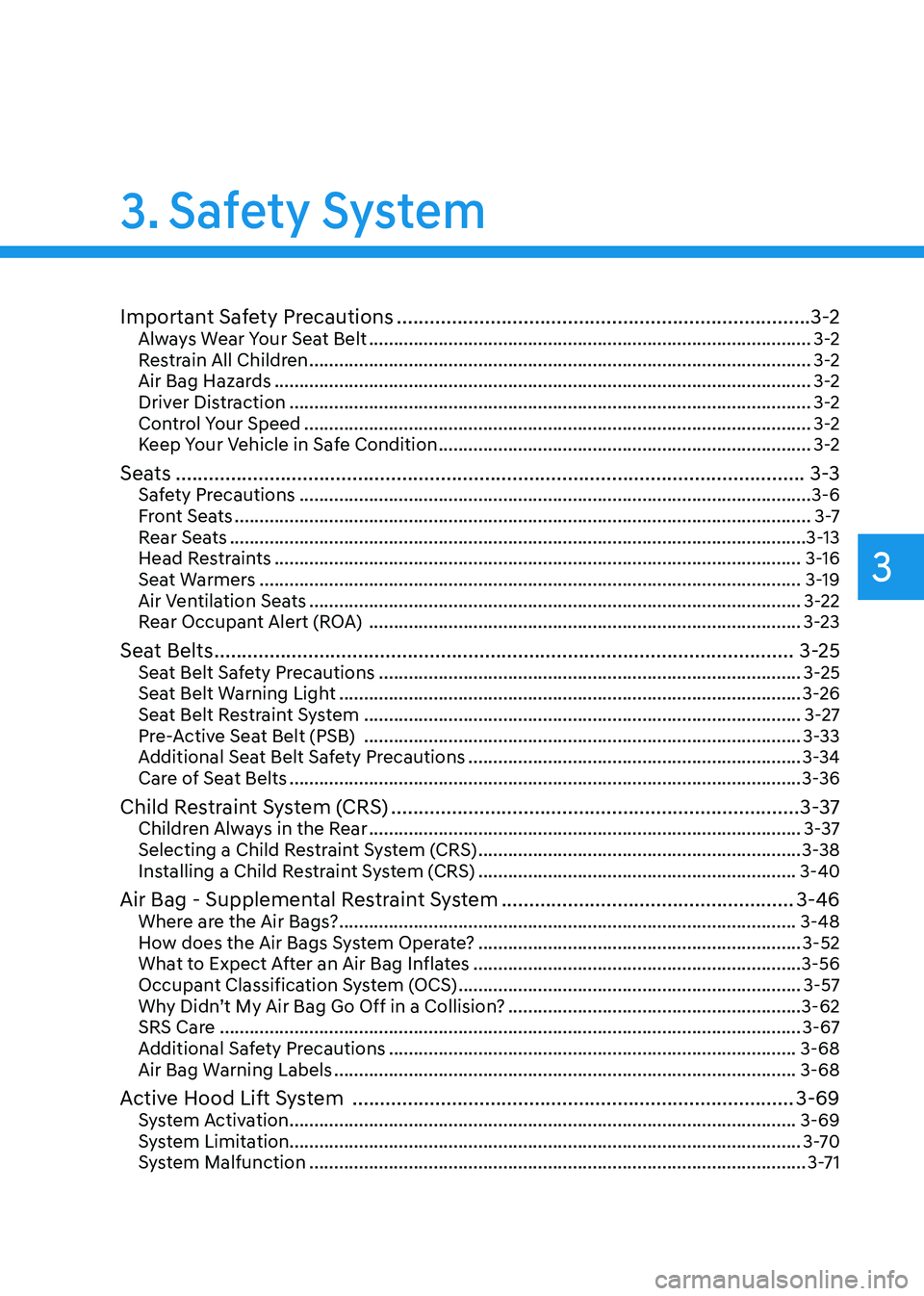
Safety System
3. Safety System
3
Important Safety Precautions ........................................................................\
...3-2Always Wear Your Seat Belt ........................................................................\
.................3-2
Restrain All Children ........................................................................\
.............................3-2
Air Bag Hazards ........................................................................\
....................................3-2
Driver Distraction ........................................................................\
.................................3-2
Control Your Speed ........................................................................\
..............................3-2
Keep Your Vehicle in Safe Condition ........................................................................\
...3-2
Seats ........................................................................\
..........................................3-3Safety Precautions ........................................................................\
...............................3-6
Front Seats ........................................................................\
............................................3 -7
Rear Seats ........................................................................\
............................................3-13
Head Restraints ........................................................................\
..................................3-16
Seat Warmers ........................................................................\
.....................................3-19
Air Ventilation Seats ........................................................................\
...........................3-22
Rear Occupant Alert (ROA) ........................................................................\
...............3-23
Seat Belts ........................................................................\
.................................3-25Seat Belt Safety Precautions ........................................................................\
.............3-25
Seat Belt Warning Light ........................................................................\
.....................3-26
Seat Belt Restraint System ........................................................................\
................3-27
Pre-Active Seat Belt (PSB) ........................................................................\
................3-33
Additional Seat Belt Safety Precautions ...................................................................3-34
Care of Seat Belts ........................................................................\
...............................3-36
Child Restraint System (CRS) ........................................................................\
..3-37Children Always in the Rear ........................................................................\
...............3-37
Selecting a Child Restraint System (CRS) .................................................................3-38
Installing a Child Restraint System (CRS) ................................................................3-40
Air Bag - Supplemental Restraint System .....................................................3-46Where are the Air Bags? ........................................................................\
....................3-48
How does the Air Bags System Operate? .................................................................3-52
What to Expect After an Air Bag Inflates ..................................................................3-56
Occupant Classification System (OCS) .....................................................................3-57
Why Didn’t My Air Bag Go Off in a Collision? ...........................................................3-62
SRS Care
........................................................................\
.............................................3-67
Additional Safety Precautions ........................................................................\
..........3-68
Air Bag Warning Labels ........................................................................\
.....................3-68
Active Hood Lift System ........................................................................\
........3-69System Activation ........................................................................\
..............................3-69
System Limitation ........................................................................\
............................... 3-70
System Malfunction
........................................................................\
............................3-71
Page 32 of 604
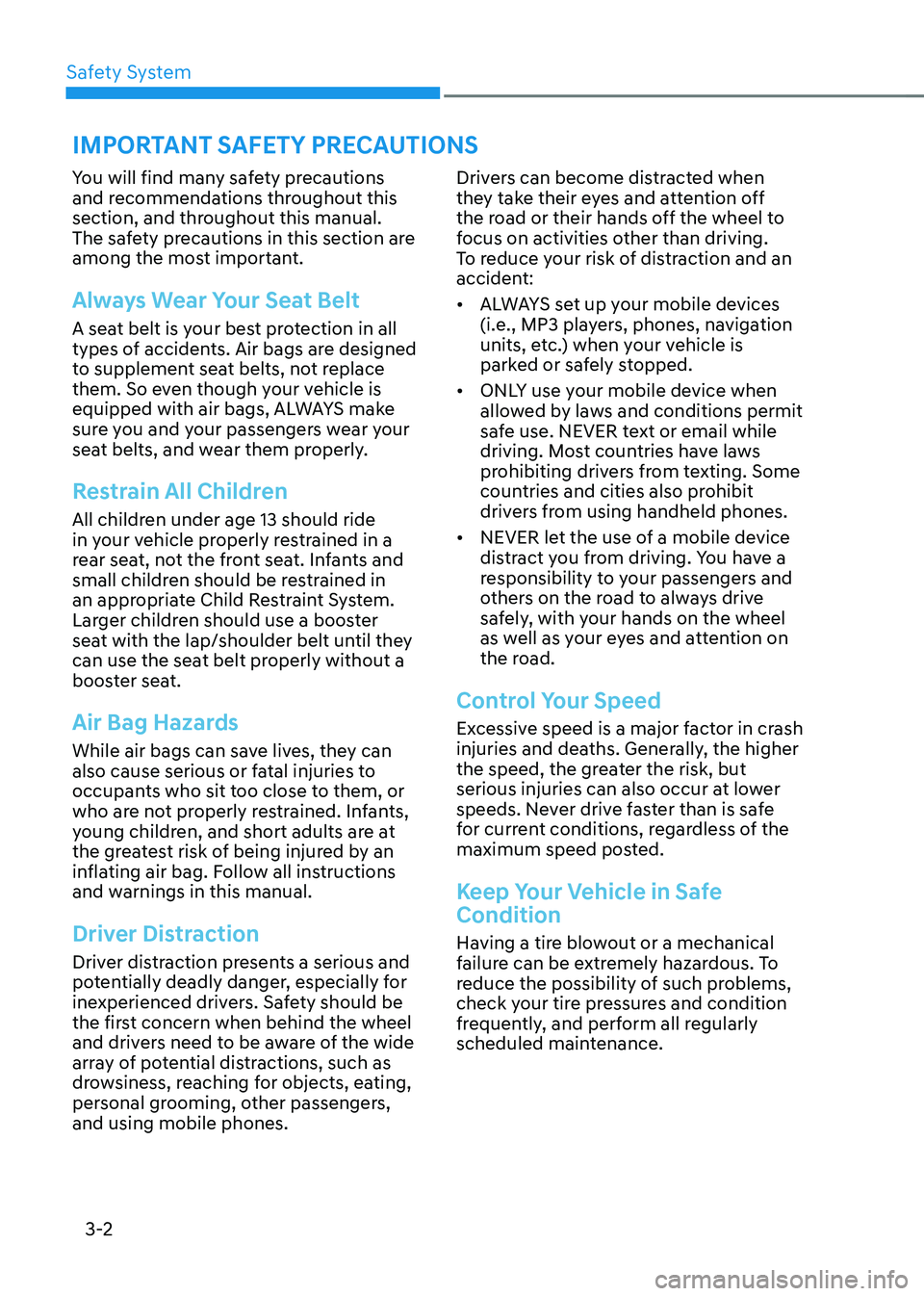
Safety System
3-2
You will find many safety precautions
and recommendations throughout this
section, and throughout this manual.
The safety precautions in this section are
among the most important.
Always Wear Your Seat Belt
A seat belt is your best protection in all
types of accidents. Air bags are designed
to supplement seat belts, not replace
them. So even though your vehicle is
equipped with air bags, ALWAYS make
sure you and your passengers wear your
seat belts, and wear them properly.
Restrain All Children
All children under age 13 should ride
in your vehicle properly restrained in a
rear seat, not the front seat. Infants and
small children should be restrained in
an appropriate Child Restraint System.
Larger children should use a booster
seat with the lap/shoulder belt until they
can use the seat belt properly without a
booster seat.
Air Bag Hazards
While air bags can save lives, they can
also cause serious or fatal injuries to
occupants who sit too close to them, or
who are not properly restrained. Infants,
young children, and short adults are at
the greatest risk of being injured by an
inflating air bag. Follow all instructions
and warnings in this manual.
Driver Distraction
Driver distraction presents a serious and
potentially deadly danger, especially for
inexperienced drivers. Safety should be
the first concern when behind the wheel
and drivers need to be aware of the wide
array of potential distractions, such as
drowsiness, reaching for objects, eating,
personal grooming, other passengers,
and using mobile phones.Drivers can become distracted when
they take their eyes and attention off
the road or their hands off the wheel to
focus on activities other than driving.
To reduce your risk of distraction and an
accident:
• ALWAYS set up your mobile devices
(i.e., MP3 players, phones, navigation
units, etc.) when your vehicle is
parked or safely stopped.
• ONLY use your mobile device when
allowed by laws and conditions permit
safe use. NEVER text or email while
driving. Most countries have laws
prohibiting drivers from texting. Some
countries and cities also prohibit
drivers from using handheld phones.
• NEVER let the use of a mobile device
distract you from driving. You have a
responsibility to your passengers and
others on the road to always drive
safely, with your hands on the wheel
as well as your eyes and attention on
the road.
Control Your Speed
Excessive speed is a major factor in crash
injuries and deaths. Generally, the higher
the speed, the greater the risk, but
serious injuries can also occur at lower
speeds. Never drive faster than is safe
for current conditions, regardless of the
maximum speed posted.
Keep Your Vehicle in Safe
Condition
Having a tire blowout or a mechanical
failure can be extremely hazardous. To
reduce the possibility of such problems,
check your tire pressures and condition
frequently, and perform all regularly
scheduled maintenance.
IMPORTANT SAFETY PRECAUTIONS
Page 53 of 604
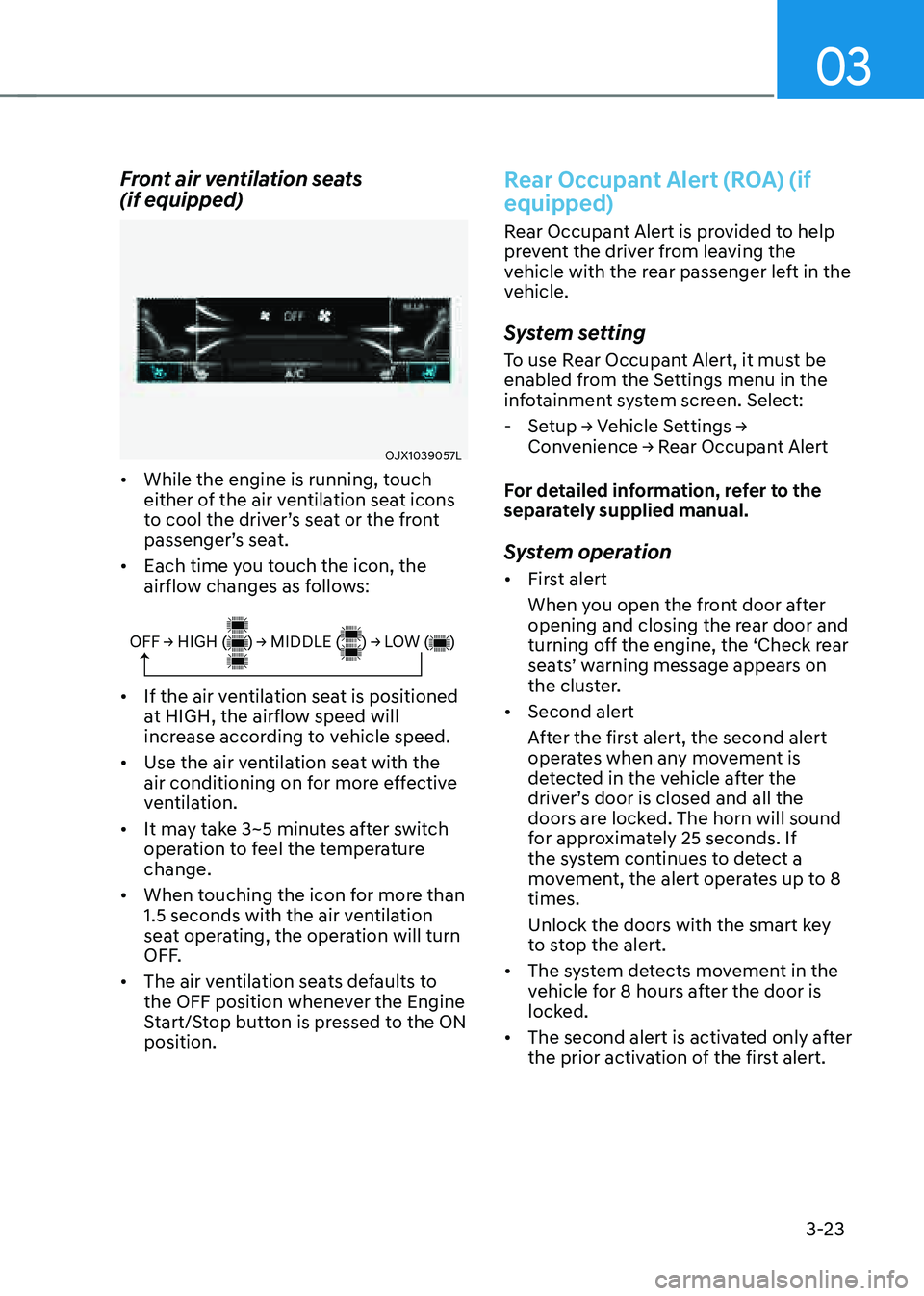
03
3-23
Front air ventilation seats
(if equipped)
OJX1039057L
• While the engine is running, touch
either of the air ventilation seat icons
to cool the driver’s seat or the front
passenger’s seat.
• Each time you touch the icon, the
airflow changes as follows:
OFF → HIGH ( ) → MIDDLE ( ) → LOW ( )
• If the air ventilation seat is positioned
at HIGH, the airflow speed will
increase according to vehicle speed.
• Use the air ventilation seat with the
air conditioning on for more effective
ventilation.
• It may take 3~5 minutes after switch
operation to feel the temperature
change.
• When touching the icon for more than
1.5 seconds with the air ventilation
seat operating, the operation will turn
OFF.
• The air ventilation seats defaults to
the OFF position whenever the Engine
Start/Stop button is pressed to the ON
position.
Rear Occupant Alert (ROA) (if
equipped)
Rear Occupant Alert is provided to help
prevent the driver from leaving the
vehicle with the rear passenger left in the
vehicle.
System setting
To use Rear Occupant Alert, it must be
enabled from the Settings menu in the
infotainment system screen. Select:
-Setup -> Vehicle Settings -> Convenience -> Rear Occupant Alert
For detailed information, refer to the
separately supplied manual.
System operation
• First alert
When you open the front door after
opening and closing the rear door and
turning off the engine, the ‘Check rear
seats’ warning message appears on
the cluster.
• Second alert
After the first alert, the second alert
operates when any movement is
detected in the vehicle after the
driver’s door is closed and all the
doors are locked. The horn will sound
for approximately 25 seconds. If
the system continues to detect a
movement, the alert operates up to 8
times.
Unlock the doors with the smart key
to stop the alert.
• The system detects movement in the
vehicle for 8 hours after the door is
locked.
• The second alert is activated only after
the prior activation of the first alert.
Page 62 of 604
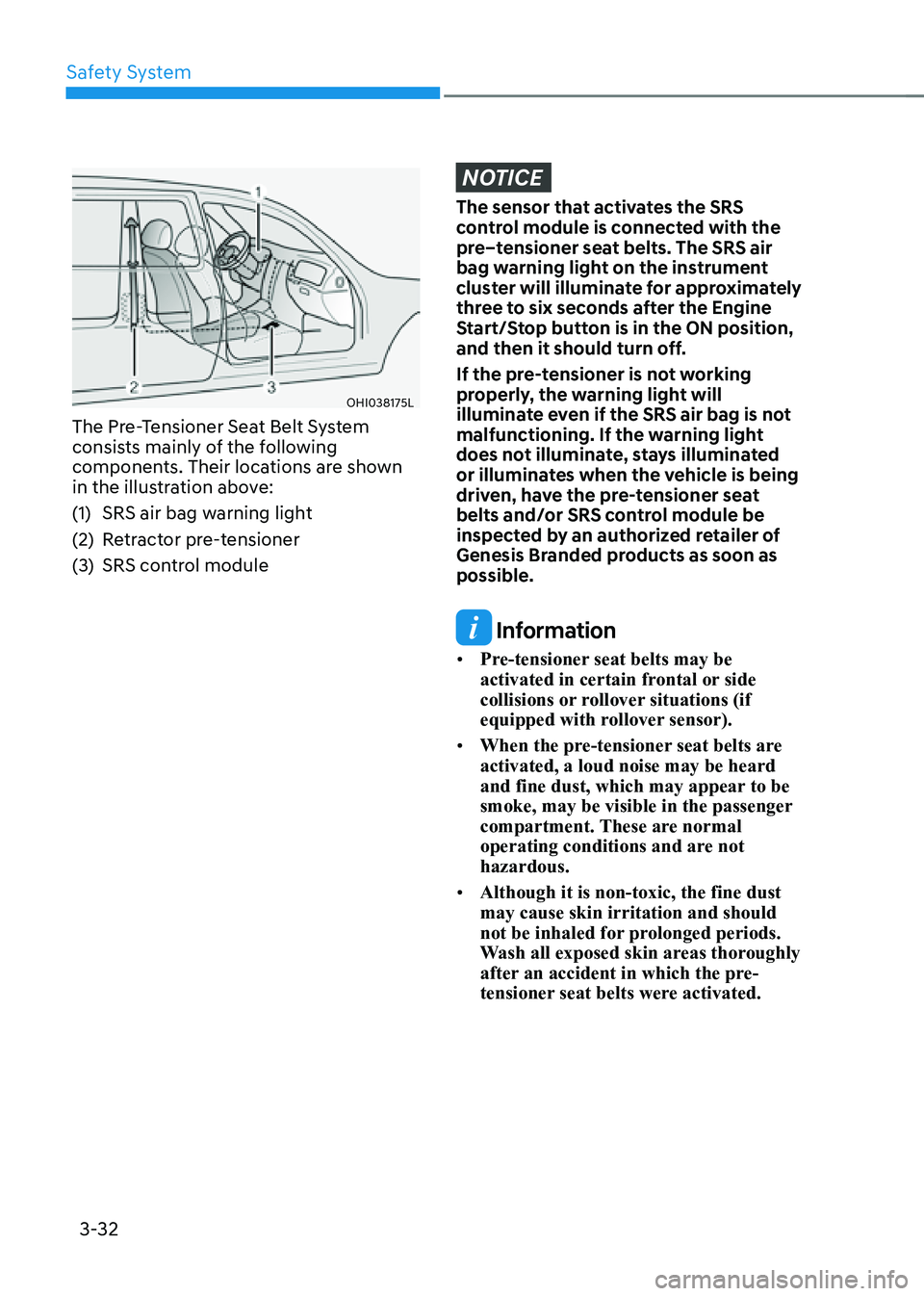
Safety System
3-32
OHI038175L
The Pre-Tensioner Seat Belt System
consists mainly of the following
components. Their locations are shown
in the illustration above:
(1) SRS air bag warning light
(2) Retractor pre-tensioner
(3) SRS control module
NOTICE
The sensor that activates the SRS
control module is connected with the
pre–tensioner seat belts. The SRS air
bag warning light on the instrument
cluster will illuminate for approximately
three to six seconds after the Engine
Start/Stop button is in the ON position,
and then it should turn off.
If the pre-tensioner is not working
properly, the warning light will
illuminate even if the SRS air bag is not
malfunctioning. If the warning light
does not illuminate, stays illuminated
or illuminates when the vehicle is being
driven, have the pre-tensioner seat
belts and/or SRS control module be
inspected by an authorized retailer of
Genesis Branded products as soon as
possible.
Information
• Pre-tensioner seat belts may be
activated in certain frontal or side
collisions or rollover situations (if
equipped with rollover sensor).
• When the pre-tensioner seat belts are
activated, a loud noise may be heard
and fine dust, which may appear to be
smoke, may be visible in the passenger
compartment. These are normal
operating conditions and are not
hazardous.
• Although it is non-toxic, the fine dust
may cause skin irritation and should
not be inhaled for prolonged periods.
Wash all exposed skin areas thoroughly
after an accident in which the pre-
tensioner seat belts were activated.
Page 74 of 604
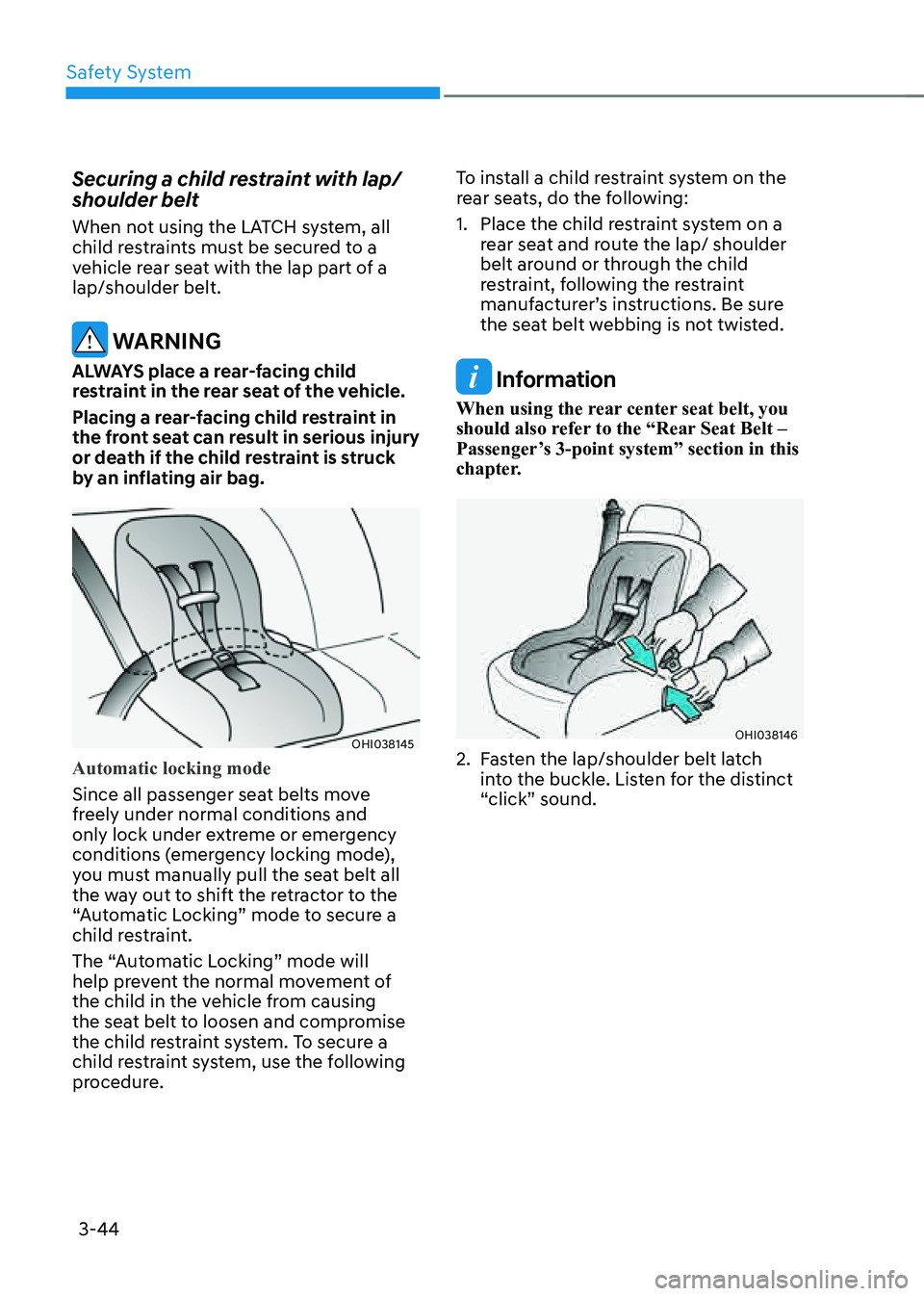
Safety System
3-44
Securing a child restraint with lap/
shoulder belt
When not using the LATCH system, all
child restraints must be secured to a
vehicle rear seat with the lap part of a
lap/shoulder belt.
WARNING
ALWAYS place a rear-facing child
restraint in the rear seat of the vehicle.
Placing a rear-facing child restraint in
the front seat can result in serious injury
or death if the child restraint is struck
by an inflating air bag.
OHI038145
Automatic locking mode
Since all passenger seat belts move
freely under normal conditions and
only lock under extreme or emergency
conditions (emergency locking mode),
you must manually pull the seat belt all
the way out to shift the retractor to the
“Automatic Locking” mode to secure a
child restraint.
The “Automatic Locking” mode will
help prevent the normal movement of
the child in the vehicle from causing
the seat belt to loosen and compromise
the child restraint system. To secure a
child restraint system, use the following
procedure.To install a child restraint system on the
rear seats, do the following:
1. Place the child restraint system on a
rear seat and route the lap/ shoulder
belt around or through the child
restraint, following the restraint
manufacturer’s instructions. Be sure
the seat belt webbing is not twisted.
Information
When using the rear center seat belt, you
should also refer to the “Rear Seat Belt –
Passenger’s 3-point system” section in this
chapter.
OHI038146
2. Fasten the lap/shoulder belt latch
into the buckle. Listen for the distinct
“click” sound.
Page 83 of 604
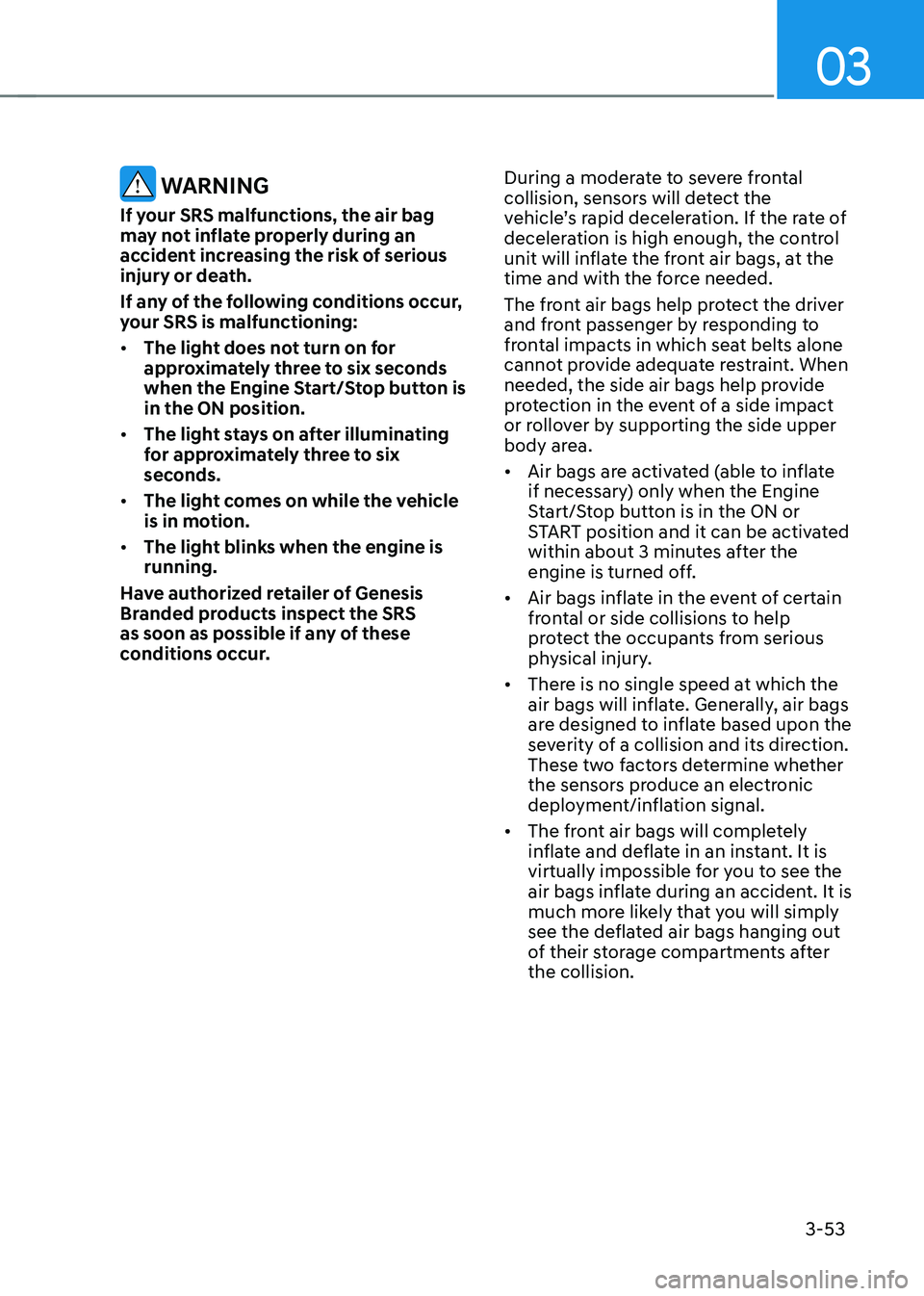
03
3-53
WARNING
If your SRS malfunctions, the air bag
may not inflate properly during an
accident increasing the risk of serious
injury or death.
If any of the following conditions occur,
your SRS is malfunctioning:
• The light does not turn on for
approximately three to six seconds
when the Engine Start/Stop button is
in the ON position.
• The light stays on after illuminating
for approximately three to six
seconds.
• The light comes on while the vehicle
is in motion.
• The light blinks when the engine is
running.
Have authorized retailer of Genesis
Branded products inspect the SRS
as soon as possible if any of these
conditions occur. During a moderate to severe frontal
collision, sensors will detect the
vehicle’s rapid deceleration. If the rate of
deceleration is high enough, the control
unit will inflate the front air bags, at the
time and with the force needed.
The front air bags help protect the driver
and front passenger by responding to
frontal impacts in which seat belts alone
cannot provide adequate restraint. When
needed, the side air bags help provide
protection in the event of a side impact
or rollover by supporting the side upper
body area.
• Air bags are activated (able to inflate
if necessary) only when the Engine
Start/Stop button is in the ON or
START position and it can be activated
within about 3 minutes after the
engine is turned off.
• Air bags inflate in the event of certain
frontal or side collisions to help
protect the occupants from serious
physical injury.
• There is no single speed at which the
air bags will inflate. Generally, air bags
are designed to inflate based upon the
severity of a collision and its direction.
These two factors determine whether
the sensors produce an electronic
deployment/inflation signal.
• The front air bags will completely
inflate and deflate in an instant. It is
virtually impossible for you to see the
air bags inflate during an accident. It is
much more likely that you will simply
see the deflated air bags hanging out
of their storage compartments after
the collision.